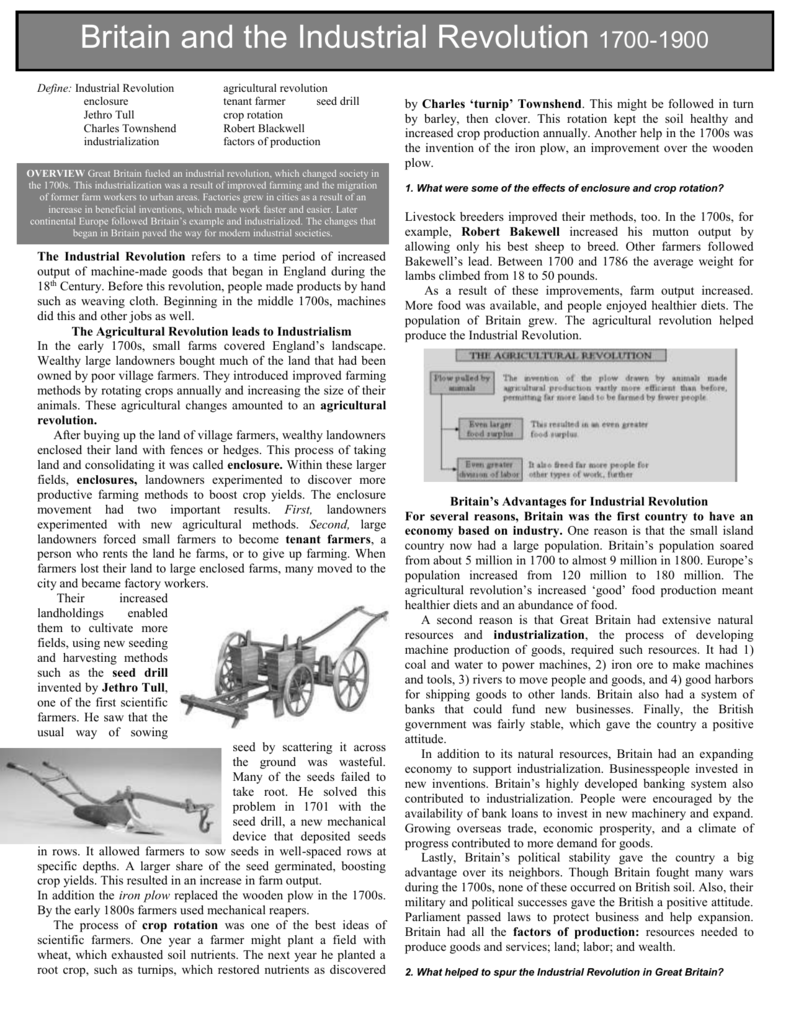During the 1700s the percentage of Europeans living in towns or cities was about. Over the last 300 years a huge range of food has become available in Britain.

1 Pages For British Industrial Revolution
Taking over and fencing off public land Which group benefited the most from the industrial revolution.

. However in the 1700s the British parliament passed legislation referred to as the Enclosure Acts which allowed the common areas to become privately owned. Officially entered the war the need for food increased even. Also theyplanted turnips which made them grow faster and they.
Your mom under her covers. Child labor slavery pollution crowded city diseases. Farmers mixed soils to get greater yields on crops.
Colonists grew enough food to support their families and in some cases were able to. Soil loosed their nutrition. But as mass production flourished people began working in factories far from home.
New kinds of crops d. Britain has always been a great trading nation. Before the advent of mechanized tools farming during colonial times was hand-labour agriculture accomplished by the hoe scythe and axe and plow.
Indentured servitude and slavery granted colonists an extended workforce to expand farming capabilities and increase their wealth. The Agricultural Revolution was the unprecedented increase in agricultural production in Britain due to increases in labor and land productivity between the mid-17th and late 19th centuries. During the agricultural revolution in the 1700s wealthy land owners increase food production by more farm worker which of the following is a reason explaining why Britain took the lead in the industrial revolution.
Report an issue. Improved farm machinery b. This book studies English agriculture in the 18th and 19th centuries based on the records of the farmers themselves.
Saffron was first introduced into Cornwall by the Phoenicians at a very early date when they first came to Britain to trade for tin. Derived from the dried and powdered stigmas of the. Improved machinery helped british farmers increase food production in the 1700s.
During the agricultural revolution in the 1700s wealthy landowners increased food production by Closure. Sketch map of farming countries. This was roughly the percentage of Europeans living in towns or cities during the 1700s crop rotation this helped British farmers increase food production in the 1700s.
Traditionally the period was seen as one of agricultural revolution but generations of historians have found it remarkably difficult to measure its salient characteristics or to locate it precisely in time. Making end slavery it ended a month after he died. What helped british farmers increase food production in the 1700s.
To the extreme south-west lay a small part of the Butter Country and in the extreme south-east there. Improved farm machinery. The Aston Martin is the most expensive British car still in production with values that continue to increase to provide the best of the best to the luxury market.
How did crop rotation increase food production. The total population itself of course is estimated by Wrigley and Schofield to have been very much larger in 1700 at just over 5 million than in 1520 24 million so that with the growth of the non- agricultural numbers the food market of 1700 must have been very greatly in excess of that available to farmers at the earlier date. Coffee and tea were widely available to buy as an expensive delicacy by the mid-17th century.
By 1780 the United States jumped on board Before this time folks typically came home to eat a midday meal. In the decades and centuries before the 1700s British farmers planted their crops on small strips of land while allowing their animals to graze on common fields shared collectively. What did farmers do during the day in the 1700s.
Reducing the size of their farms c. What role did William Wilberforce play in the abolition of slavery in the british empire. The heartland of America was about the only major agricultural area still in full production.
In the 12th century the Crusaders were the first Britons to taste oranges and lemons whilst in Jaffa in 1191-2. Agricultural output grew faster than the population over the century to 1770 and thereafter productivity remained among the highest in the world. In the north was the Cheese Country devoted to cheese dairy farming and grazing.
Once the British colonists solidified their hold in the new world access to food proved to be different from of the days of John Smith and colonial Jamestown. Today we think nothing of eating broccoli 1700 tomatoes 1750 chocolate bars 1847 and baked beans 1886 foods that only relatively recently. That program was essentially an export program for farmers.
In the 16th century Wiltshire excluding enclaves comprehended parts of various farming regions. Why did an increased number of sheep on farms lead people to move to. Which of the following helped British farmers increase food production in the 1700s.
Reducing the size of their farms. Which of the following helped British farmers increase food production in the 1700s. The government bought food commodities that had been in surplus before the war and shipped them to the Allies.
This meant they had to pack lunch or buy food from a nearby. These tools in conjunction with cheap labor made available by slaves allowed for increasingly sustaining harvests and the production of crops for trade. The Industrial Revolution which took place from 1760 to 1840 started in Great Britain.

Forces For Change 2 Major Developments In 1700 S Forced Traditional Society To Change Population Growth Britain S Population In 1700 5 5 Million Britain S Ppt Download

Industrial Revolution Period Where The Means Of Production Of Goods Shifted From Making Things By Hand To Making Things With Machines From Use Of Ppt Download

World History Review Ppt Download

Agricultural Revolution History Crunch History Articles Biographies Infographics Resources And More
0 Comments